Part of a series of articles titled Volcano Types.
Article
Cinder Cones
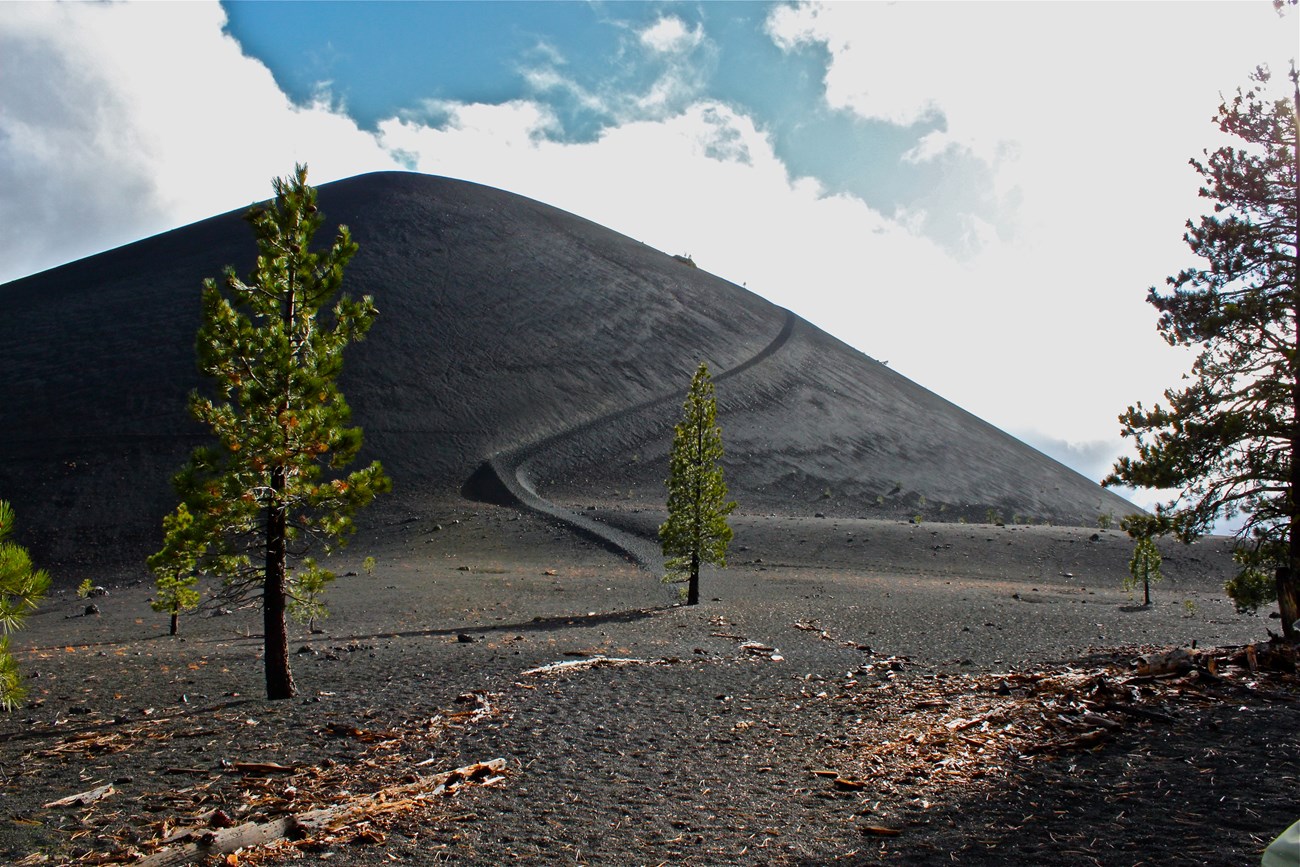
NPS photo.
Introduction
Cinder cones are the most common type of volcano in the world. They may look like an idealized depiction of a volcano as they are steep, conical hills that usually have a prominent crater at the top.
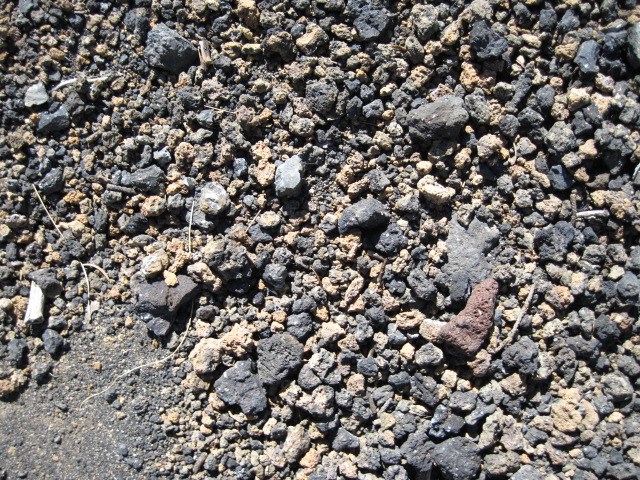
Photograph by Katie KellerLynn (Colorado State University).
Cinder cones are more technically known as scoria cones. Scoria are irregularly-shaped, highly vesicular (bubble-shaped cavities) fragments of lava that are erupted into the air and are typically solid when they land. Cinder is a more colloquial term that is widely used in the United States for pieces of scoria that are roughly nut- to fist-size.
Cinder cones are often surrounded by dark lava flows erupted from near their base.
National Park Cinder Cones
Cinder cones are the most common type of volcano in the National Park System. At least 24 units in the National Park System contain cinder cones.
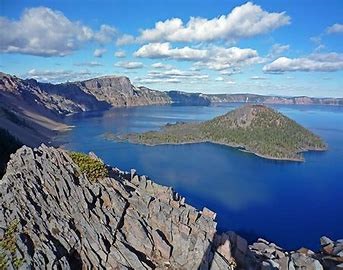
NPS Photo.
-
Capulin Volcano and Sunset Crater Volcano national monuments were established specifically to preserve especially large and picturesque cinder cones. These volcanoes are the tallest cinder cones in the National Park System with a height of approximately 1000 feet (300 m) each.
-
Wizard Island in Crater Lake National Park is a cinder cone that formed after the caldera-forming eruption.
-
Craters of the Moon National Monument contains 25 cinder cones.
-
Cinder Cone in Lassen Volcanic National Park erupted about 1650 CE.
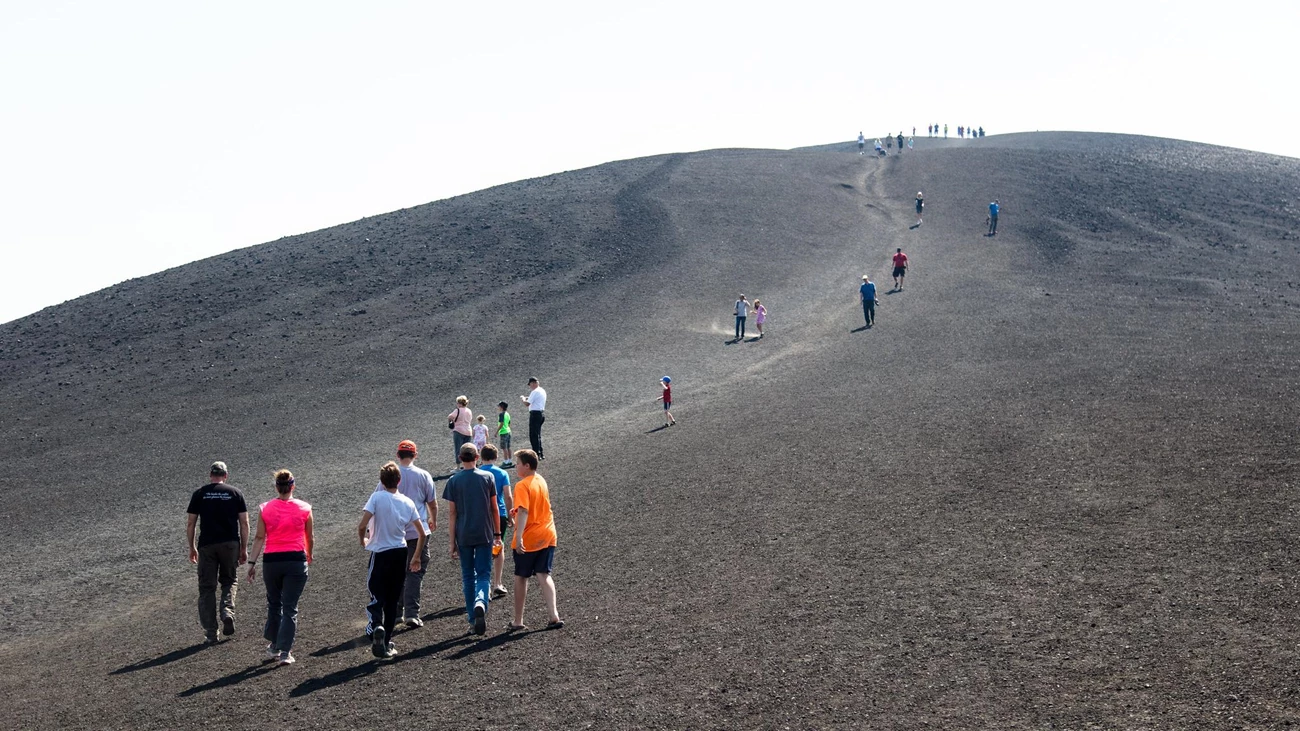
NPS photo.
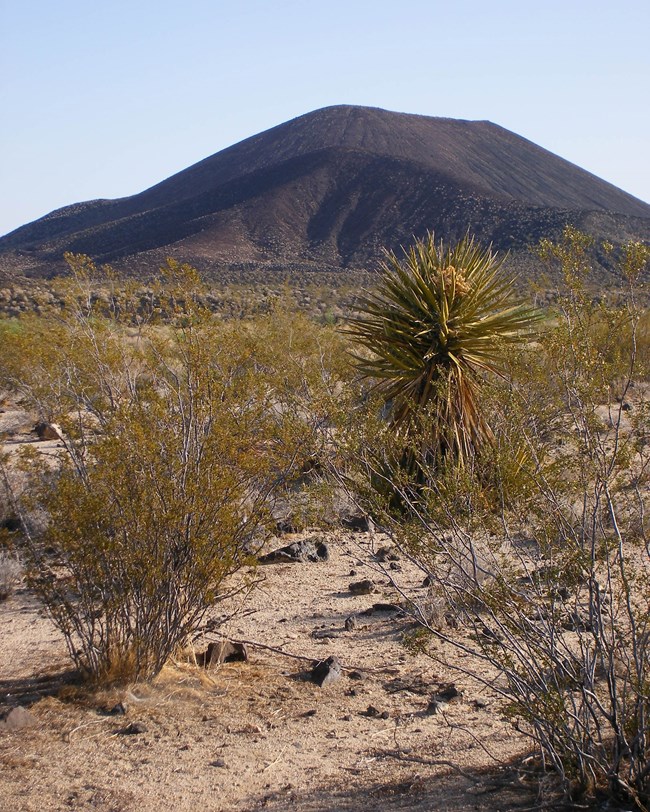
-
Several large cinder cones are located in Haleakala National Park.
-
Cinder Cone National Natural Landmark is a cluster of approximately 20 young cinder cones in Mojave National Preserve.
Photo (right): Cinder Cone National Natural Landmark in Mojave National Preserve, California.
NPS photo.
Overall Description
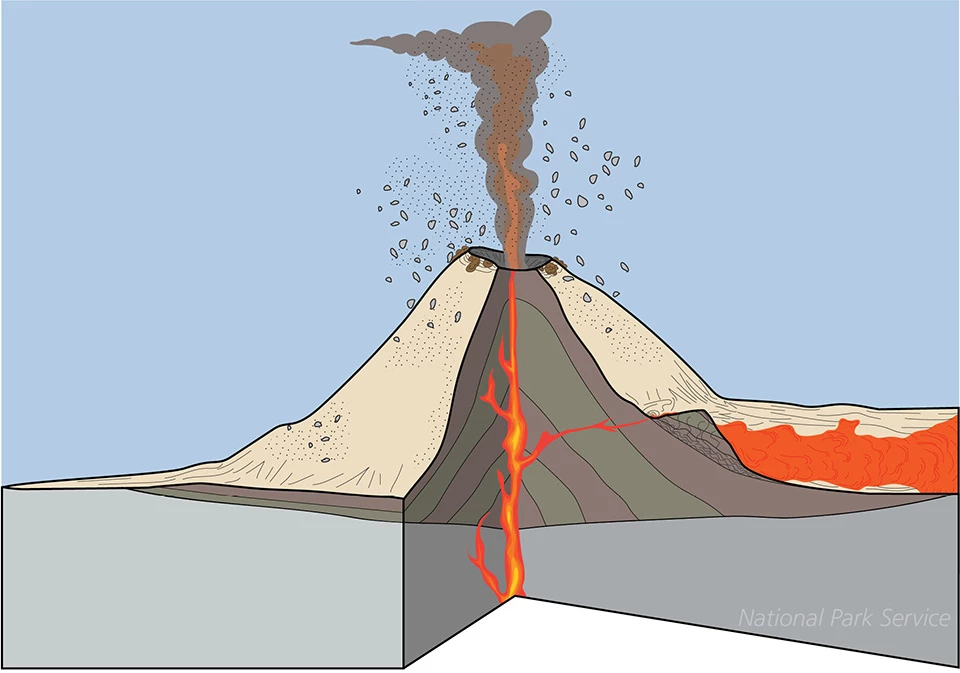
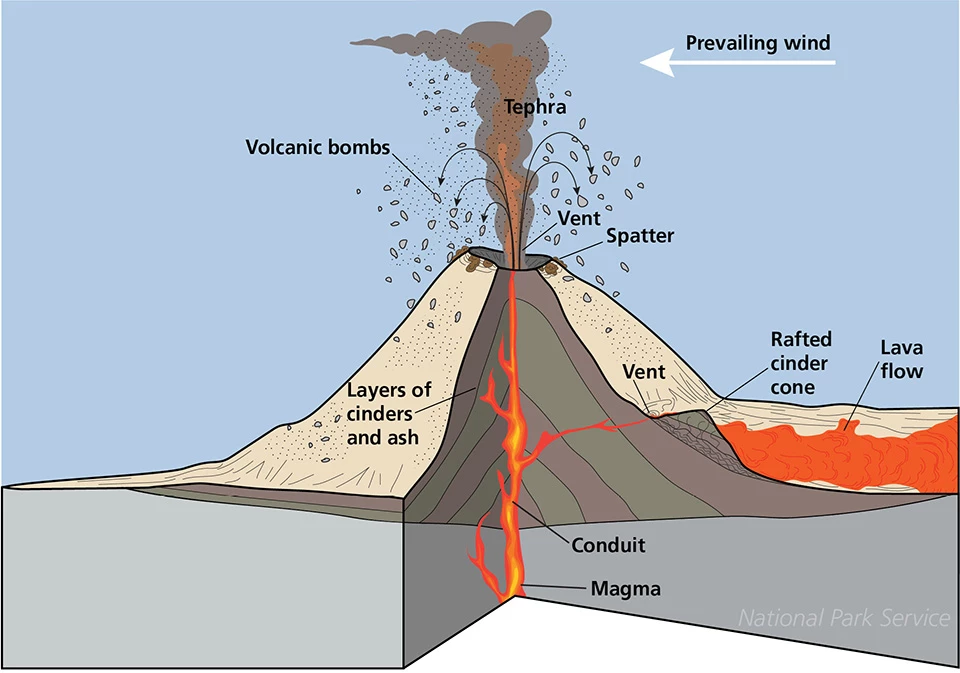
Left image
Schematic diagram of a cinder cone volcano.
Credit: TTE
Right image
Diagram with feature labels.
Credit: TTE
Most cinder cones are a few hundred feet tall (100 to 150 m), and rarely are larger than 600 to 900 feet (200 to 300 m) in height. Each cinder cone usually is its own edifice built up around a central vent.
While sometimes they are nearly perfect cones like Sunset Crater Volcano, cinder cones frequently have an asymmetric shape. Cinder cones that form over a linear fissure vent are elongated, and ones that form in areas with strong prevailing winds may be much taller on the downwind side. Elongated cinder cones may also form when the location of the vent shifts during the eruption. They may also be breached when lava flows erupting from near the base of the cone carry away a part of the flank.
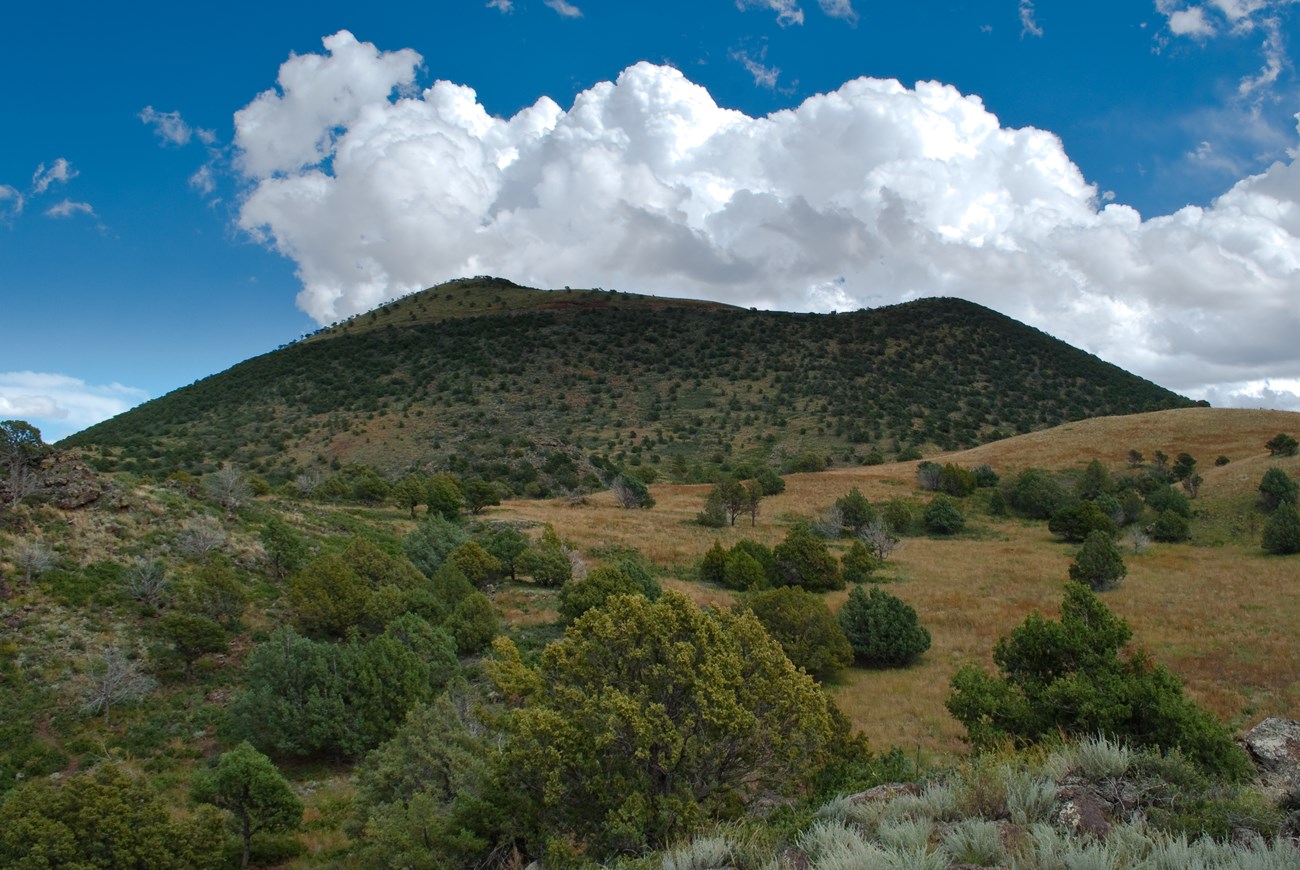
NPS photo.
Magma Composition
Most cinder cones are basaltic to basaltic andesite in composition, but they may be andesitic (intermediate).
Eruption Types & Classification
The eruptions of most cinder cones are usually mildly to moderately explosive (Strombolian to Vulcanian), but rarely can have Sub-Plinian activity.
Their usually low explosivity is due to the low viscosity and low volatile content of magma.
Cinder cone eruptions are usually at 1-2 on the Volcanic Explosivity Index (VEI), but rarely may be as high as 4.
Cinder cones are generally monogenetic, meaning that they are the product of a single eruptive episode. After an eruption has ended, the plumbing system connecting the magma source area to the vent is blocked by rock (e.g., solidified magma).
Cinder cone eruptions usually have a short duration. Half of all historic cinder cone eruptions have lasted less than 30 days; and 95% have lasted less than 1 year.
Occurrence
Cinder cones commonly occur in association with other volcanoes. They may occur within calderas, near volcanic domes, and as satellite cones on the flanks of composite and shield volcanoes. Cinder cones frequently occur in volcanic fields with as many as hundreds of other cinder cones.
Geologic Features on Cinder Cones
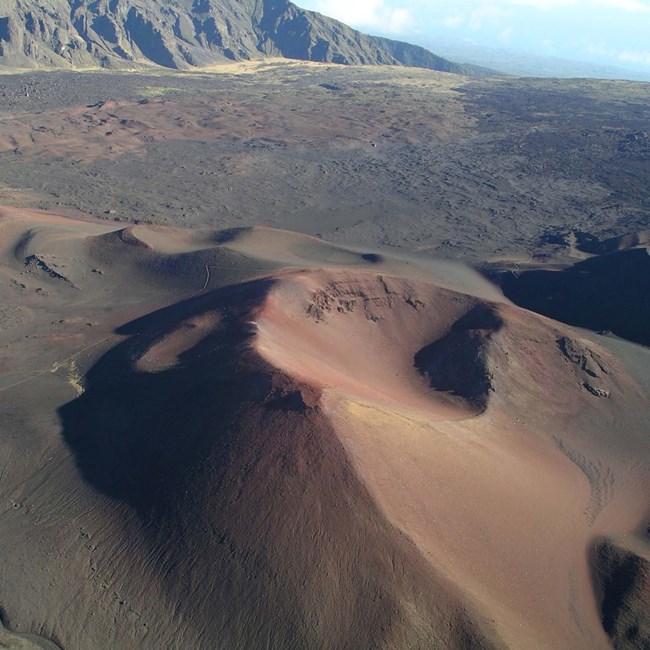
Occurrence
Cinder cones commonly occur in association with other volcanoes. They may occur within calderas, near volcanic domes, and as satellite cones on the flanks of composite and shield volcanoes. Cinder cones frequently occur in volcanic fields with as many as hundreds of other cinder cones.
Photo (right): A bird’s eye view over Ka Moa o Pele cinder cone, flanked by dark and light lava flows at Haleakalā National Park, Hawaii.
NPS photo by Russell Shurtz.
Geologic Features on Cinder Cones
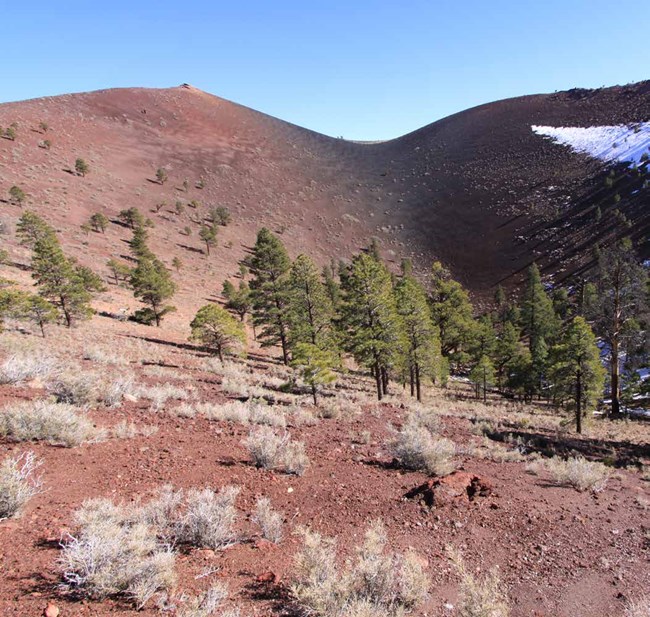
Crater
Most cinder cones have a pronounced volcanic crater at the top. Capulin Volcano has a trail into the crater and around its rim.
Layers of Ash and Cinders
Cinder cones are made up of layers of pebble-sized or larger cinders and layers of ash. Larger volcanic bombs and blocks may also be present.
Photo (right): Sunset Crater Volcano's crater. The red color is from oxidized cinders. Hikers aren't allowed to climb Sunset Crater because the fragile cinder slopes are easily damaged.
NPS photo by C. Schelz.
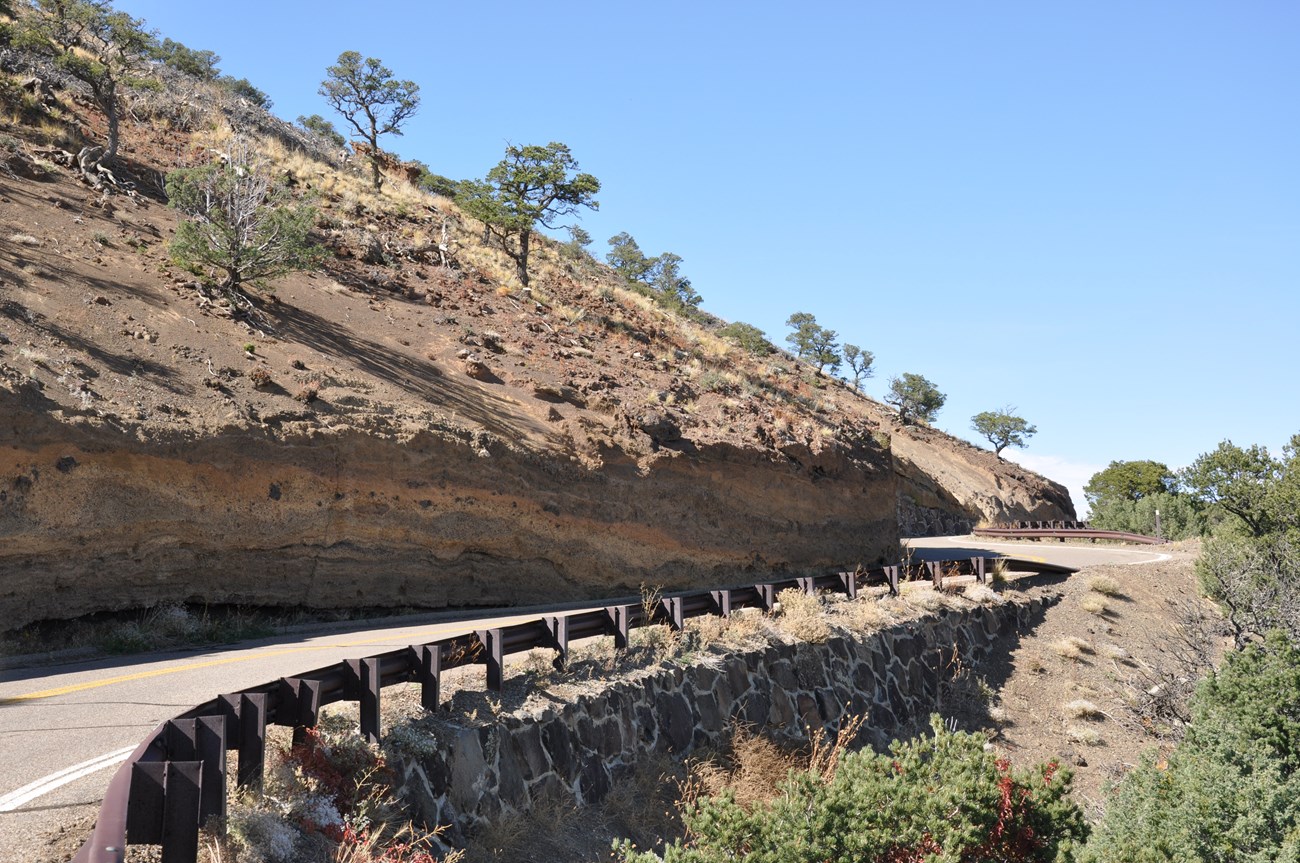
USGS photo.
The overall slope of a cinder cone is determined by the angle of repose, which for ash and cinders is between 25 and 32°. Cinders that pile up around the vent may exceed the angle of repose periodically during an eruption. When this happens, cinders and ash avalanche down the sides of the cone and into the crater to reestablish a slope at the angle of repose. These avalanches play an major role in forming the layering in cinder cones.
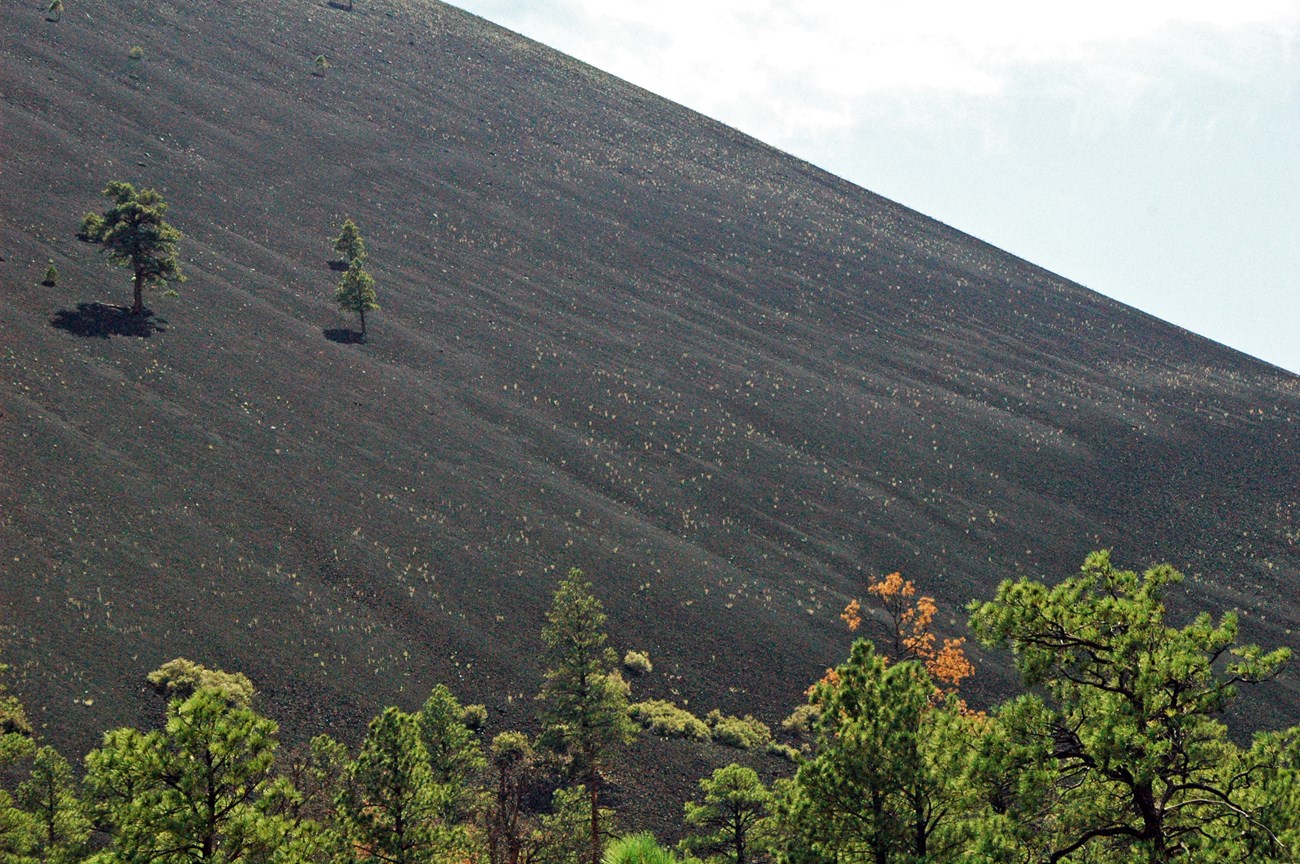
John St James flickr image.
Spatter
During waning stages, cinder cone eruptions become less explosive. As a result, cinders and globs of lava are not ejected as high into the air, and may still be molten or partially molten when they land. These may weld together to form deposits called spatter, which may resemble lava. Spatter deposits may form protective armor around the rim of a cinder cone, slowing erosion. Spatter deposits on Capulin Volcano’s rim and crater is largely responsible for its youthful (e.g., largely uneroded) appearance although it formed more than 54,000 years ago.
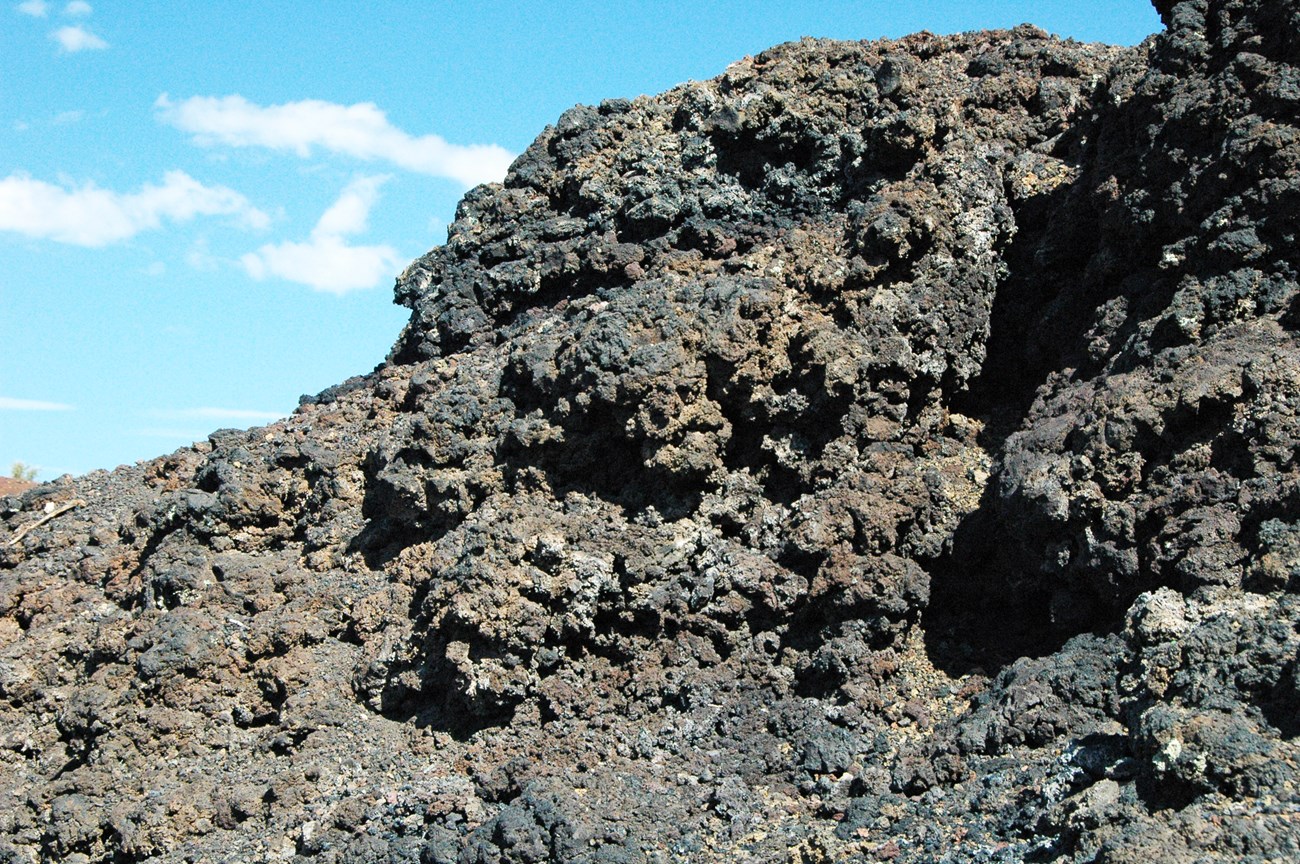
John St James flickr image.
Side Vent
Most cinder cones have a vent at the base or side of the volcano where basaltic lava flows are erupted. These basal vents are sometimes called cones are called bocas or boccas (Spanish or Italian respectively for “mouth”). The side vent areas may be complex and contain a variety of features such as lava lakes, spatter deposits, push-ups, and even pieces of the cinder cones flank that were carried away as rafts by the erupting lava flows.
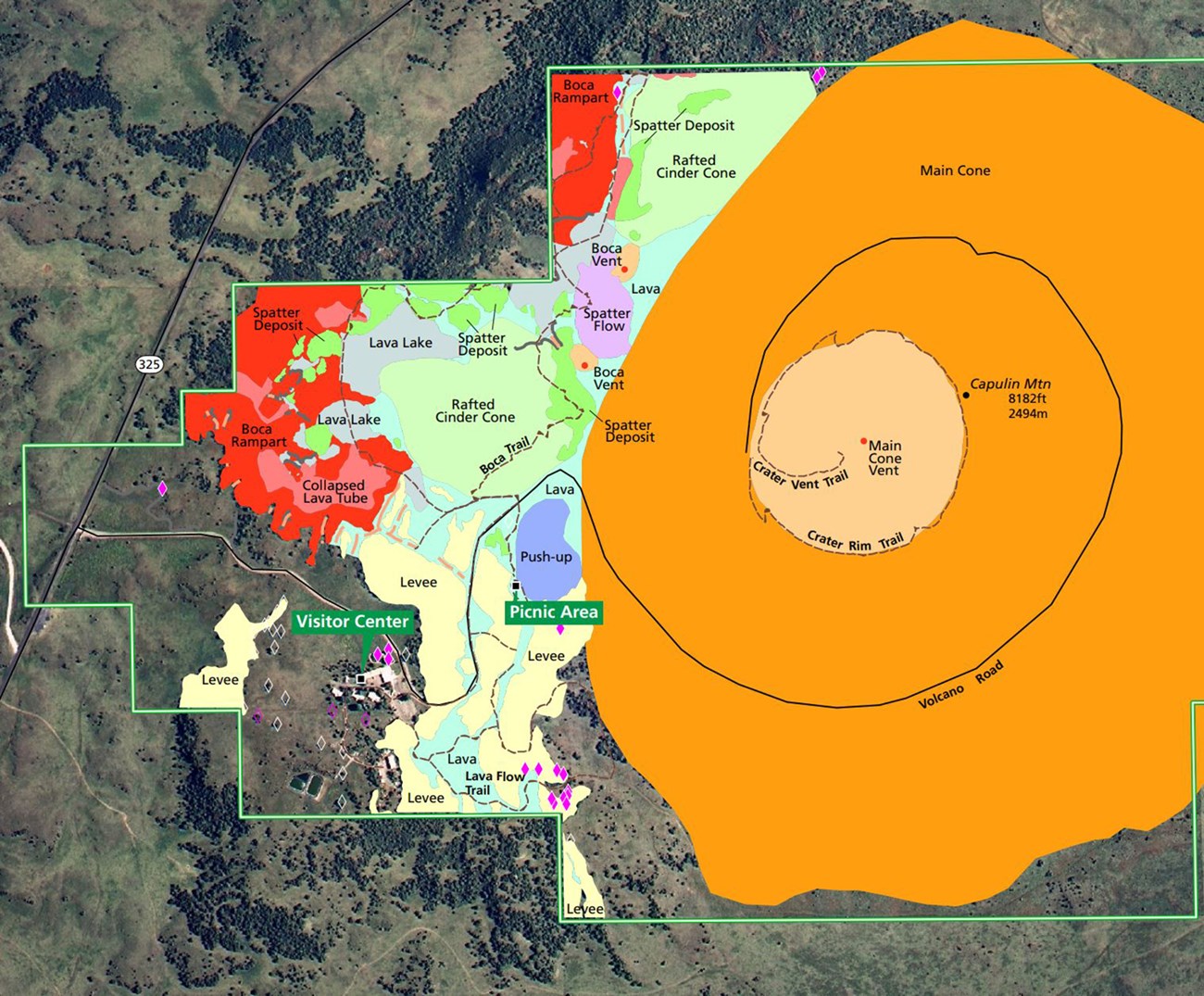
NPS Geologic Resources Inventory.
Volcanic Hazards
Because cinder cones are usually monogenetic, there should not be a risk of eruption at an existing cinder cones. But a new cinder cone may form nearby if an eruption commences. Precursors to cinder cone eruptions include earthquakes and rumblings (subterranean noises).
Geohazards on existing cinder cones include rockfall, debris flows, and other mass wasting events on the slopes.
Other Notes
Cinder cones are the “most endangered” volcanoes on Earth because of the many uses humans have for cinders. They are easily mined for cinders to use in road construction, to sand icy roads, and for “lava rocks” for gas grills.
National Park Sites with Cinder Cones
-
Aniakchak National Monument (ANIA), Alaska—[ANIA Geodiversity Atlas] [ANIA Park Home] [ANIA npshistory.org]
-
Bandelier National Monument (BAND), New Mexico—[BAND Geodiversity Atlas] [BAND Park Home] [BAND npshistory.org]
-
Bering Land Bridge National Preserve (BELA), Alaska—[BELA Geodiversity Atlas] [BELA Park Home] [npshistory.org]
-
Capulin Volcano National Monument (CAVO), New Mexico—[CAVO Geodiversity Atlas] [CAVO Park Home ] [CAVO npshistory.org]
-
Crater Lake National Park (CRLA), Oregon—[CRLA Geodiversity Atlas] [CRLA Park Home] [CRLA npshistory.org]
-
Craters of the Moon National Monument (CRMO), Idaho—[CRMO Geodiversity Atlas] [CRMO Park Home] [CRMO npshistory.org]
-
Death Valley National Park (DEVA), California and Nevada—[DEVA Geodiversity Atlas] [DEVA Park Home] [DEVA npshistory.org]
-
El Malpais National Monument (ELMA), New Mexico—[ELMA Geodiversity Atlas] [ELMA Park Home] [ELMA npshistory.org]
-
Grand Canyon National Park (GRCA), Arizona—[GRCA Geodiversity Atlas] [GRCA Park Home] [GRCA npshistory.org]
-
Grand Canyon-Parashant National Monument (PARA), Arizona—[PARA Park Home] [PARA npshistory.org]
-
Haleakala National Park (HALE), Hawaii—[HALE Geodiversity Atlas] [HALE Park Home] [HALE npshistory.org]
-
Hawai’i Volcanoes National Park (HAVO), Hawai'i—[HAVO Geodiversity Atlas] [HAVO Park Home] [HAVO npshistory.org]
-
Katmai National Park (KATM), Alaska—[KATM Geodiversity Atlas] [KATM Park Home] [KATM npshistory.org]
-
Lake Mead National Recreation Area (LAKE), Arizona and Nevada—[LAKE Geodiversity Atlas] [LAKE Park Home] [LAKE npshistory.com]
-
Lassen Volcanic National Park (LAVO), California—[LAVO Geodiversity Atlas] [LAVO Park Home] [LAVO npshistory.com]
-
Lava Beds National Monument (LABE), California—[LABE Geodiversity Atlas] [LABE Park Home] [LABE npshistory.com]
-
Mojave National Preserve (MOJA), California—[MOJA Geodiversity Atlas] [MOJA Park Home] [MOJA npshistory.com]
-
Mount Rainier National Park (MORA), Washington—[MORA Geodiversity Atlas] [MORA Park Home] [MORA npshistory.com]
-
National Park of American Samoa (NPSA), American Samoa—[NPSA Geodiversity Atlas] [NPSA Park Home] [NPSA npshistory.com]
-
Petroglyph National Monument (PETR), New Mexico—[PETR Geodiversity Atlas] [PETR Park Home] [nPETRpshistory.com]
-
Sunset Crater Volcano National Monument (SUCR), Arizona—[SUCR Geodiversity Atlas] [SUCR Park Home] [SUCR npshistory.com]
-
Wrangell-St. Elias National Park and Preserve, Alaska—[WRST Geodiversity Atlas] [WRST Park Home] [WRST npshistory.com]
-
Yellowstone National Park (YELL), Wyoming—[YELL Geodiversity Atlas] [YELL Park Home] [YELL npshistory.com]
-
Zion National Park (ZION), Utah—[ZION Geodiversity Atlas] [ZION Park Home] [ZION npshistory.com]
Related Links
Tags
- aniakchak national monument & preserve
- bandelier national monument
- bering land bridge national preserve
- capulin volcano national monument
- crater lake national park
- craters of the moon national monument & preserve
- death valley national park
- el malpais national monument
- grand canyon national park
- grand canyon-parashant national monument
- haleakalā national park
- hawaiʻi volcanoes national park
- katmai national park & preserve
- lake mead national recreation area
- lassen volcanic national park
- lava beds national monument
- mojave national preserve
- mount rainier national park
- national park of american samoa
- petroglyph national monument
- sunset crater volcano national monument
- wrangell - st elias national park & preserve
- yellowstone national park
- zion national park
- cinder cones
- volcanoes
- volcano types
- geology
Last updated: April 2, 2024
